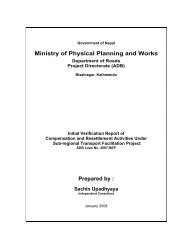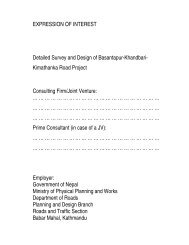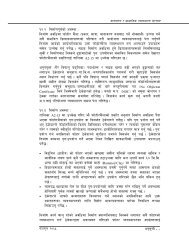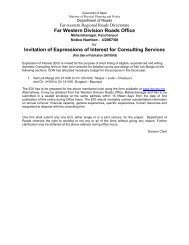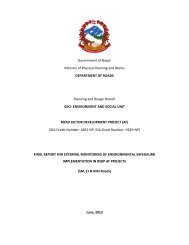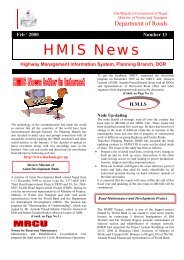Environmental & Social Management Framework - About ...
Environmental & Social Management Framework - About ...
Environmental & Social Management Framework - About ...
You also want an ePaper? Increase the reach of your titles
YUMPU automatically turns print PDFs into web optimized ePapers that Google loves.
<strong>Environmental</strong> and <strong>Social</strong> <strong>Management</strong> <strong>Framework</strong>roads reduce the immediate impacts of traffic on the community, and localcommercial activities sometimes flourish as a result.On the negative side, communities may fear a loss of business from the diversionof traffic, and some community activities may “migrate” to the new route,potentially changing existing land use patterns and possibly undermining theobjective of greater control of access on the new route. By-passes, like otherroad projects, can also cause changes in vehicle flow on the secondary network,possibly creating nuisances if traffic should increase at some locations.d. Conflicts in or with nearby Host CommunitiesWhile most resettlement planning concentrates on those people who need to beresettled, the community or communities that receive and absorb the resettlersmust also be taken into consideration. In regions where arable land is scarce, orwhether other basic resources such as fuel wood and water are in short supply,the impacts on the host community from the influx of a new group of ''users" canbe severe and highly controversial, leading at times to frictions and even physicalclashes.The host areas' ability to sustain a resettled population without serious resourcedepletion should also be assessed. Important factors to consider include:• Availability of clean water (in all seasons)• Amount of productivity of agricultural land• Utilities• Health services• Education facilities• Sewage disposal and water delivery systems• Road networkGreat care must be taken to avoid resettling people in areas where they will beviewed as trespassers talking up resources in short supply, or in areas which aretotally foreign to them. In the former case, the resettlement can become a majorsource of tension within the community and may end up being the basis forenduring conflict. In the later case, people who are resettled in unfamiliarenvironments may have considerable difficulty adjusting, e.g. having to learn newagricultural methods to apply on different soils. Resettlement may drive thesepeople into long-lasting poverty or destituteness.e. Impacts on Vulnerable Indigenous People and DalitsIndigenous people and Dalits are commonly among the poorest segments of apopulation, especially in the remote areas of Nepal. Dalits have the lowest statusin all sense, i.e. lacking land resources, livestock, education, sufficient income,access to all services and facilities (including cultural and religious). In many ruralareas it is the tradition that Dalits depend on Adhibasi/Janajatis (indigenouspeople) and so-called higher castes for livelihood whereas the indigenous groupsdepend partly on higher castes for supporting their livelihoods. Indigenous peopleengage in economic activities that range from shifting agriculture in or nearforests to wage labour or even small-scale market-oriented activities.The cultural, social, political and economic integrity that characterizes indigenouspeoples renders their lives vulnerable to disruptions from outside. Whether a roadis being planned to cross an area inhabited by indigenous peoples or to open upthat same area, it will have a marked effect on their lives. A ‘Cultural ShockEffect’ is not uncommon when isolated communities are exposed relativelyrapidly to increased communication with the outside world.April 2007 Chapter 4-23



![j:6 ]zg cfof ]hgf](https://img.yumpu.com/51286794/1/190x245/j6-zg-cfof-hgf.jpg?quality=85)

![x'nfsL /fhdfu { cfof ]hgf](https://img.yumpu.com/50581959/1/190x245/xnfsl-fhdfu-cfof-hgf.jpg?quality=85)
